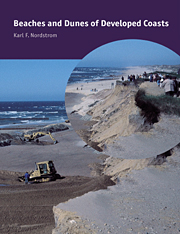Book contents
- Frontmatter
- Contents
- Preface
- Acknowledgements
- 1 The developed coastal landscape: temporal and spatial characteristics
- 2 Altering landforms to suit human needs
- 3 Replenishing landforms
- 4 Effects of structures on landforms and sediment availability
- 5 Characteristics of human-altered coastal landforms
- 6 Temporal scales of landscape change
- 7 Management programs
- 8 Maintaining and enhancing natural features in developed landscapes
- 9 Directions for geomorphological research
- References
- Index
9 - Directions for geomorphological research
Published online by Cambridge University Press: 18 December 2009
- Frontmatter
- Contents
- Preface
- Acknowledgements
- 1 The developed coastal landscape: temporal and spatial characteristics
- 2 Altering landforms to suit human needs
- 3 Replenishing landforms
- 4 Effects of structures on landforms and sediment availability
- 5 Characteristics of human-altered coastal landforms
- 6 Temporal scales of landscape change
- 7 Management programs
- 8 Maintaining and enhancing natural features in developed landscapes
- 9 Directions for geomorphological research
- References
- Index
Summary
Overview
Developed coasts evolve as a result of direct and indirect human actions that are occurring at larger scale and higher frequency through time due to improvements in technology and increases in the economic value of coastal property. Coastal landforms are eliminated, reshaped, remobilized, stabilized or entirely re-created as artifacts. The resulting landforms differ from natural landforms internally and externally and are generally: (1) less dynamic; (2) less diverse in vegetation cover; (3) smaller in area; and (4) subject to cycles of evolution that correspond more closely to human processes than natural processes (at least in the depositional phase). If they are enhanced or restored by human efforts, the alterations are usually designed to provide a small number of utility functions.
Existing human actions and regulations cannot ensure that landforms in the future will have the size, dynamism, topographic and species diversity to provide the number and variety of resource options available in the naturally functioning coastal landscapes that are being lost through incompatible development. Actions can be made more compatible with natural processes, but this will involve compromise solutions that are likely to be viewed as undesirable by many stakeholders.
The preceding chapters provide a review of the state of knowledge of the processes affecting beaches and dunes on developed coasts and the resulting landform characteristics, along with suggestions for ways that natural values can be maintained while accommodating human use.
- Type
- Chapter
- Information
- Beaches and Dunes of Developed Coasts , pp. 261 - 286Publisher: Cambridge University PressPrint publication year: 2000



